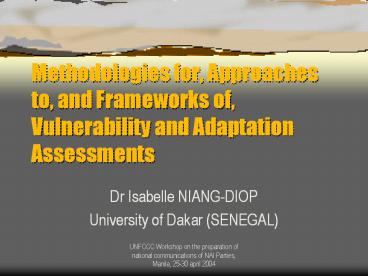Methodologies for, Approaches to, and Frameworks of, Vulnerability and Adaptation Assessments - PowerPoint PPT Presentation
1 / 21
Title:
Methodologies for, Approaches to, and Frameworks of, Vulnerability and Adaptation Assessments
Description:
Methodologies for, Approaches to, and Frameworks of, Vulnerability and ... Exposure units to be studied (sectors, ecosystems, ... Time frame (time horizons) ... – PowerPoint PPT presentation
Number of Views:134
Avg rating:3.0/5.0
Title: Methodologies for, Approaches to, and Frameworks of, Vulnerability and Adaptation Assessments
1
Methodologies for, Approaches to, and Frameworks
of, Vulnerability and Adaptation Assessments
- Dr Isabelle NIANG-DIOP
- University of Dakar (SENEGAL)
2
What do we mean by..?
- Just ways to produce VA studies
- The main methodologies/frameworks
- The first generation IPCC guidelines 1994
- CGE work synthesis of first VA studies
weakness of adaptation strategies - The second generation 2002-2003
- the Adaptation Policy Framework adaptation
oriented - The NAPAs
- Uncertainty-Risk decision making tools the
UKCIP methodology
3
The IPCC Technical Guidelines (Carter et al.,
1994)
4
The IPCC Guidelines
- Step 1 Define the problem
- Goals of the assessment
- Exposure units to be studied (sectors,
ecosystems,..) - Study area (administrative, geographical,
ecological units, ) - Time frame (time horizons)
- Data needs identify data requirements (type,
source, quantity, quality,) - The context of the study political, economic,
global changes, etc. - Step 2 Select the method
5
The IPCC Guidelines
- Step 2 Select the method
- Experimentation
- Models biophysical, economic, integrated
- Analogues historical, geographical
- Expert judgement
- Step 3 Test the method
- Step 4 Select the scenarios
- The baselines climatological, environmental,
socio-economic - The scenarios mainly climate change scenarios
(MAGICC-SCENGEN), environmental and
socio-economic projections
6
The IPCC Guidelines
- Step 5 Assess the impacts
- Qualitative assessments
- The use of models (CERES, Bruun rule, WATBAL,
Holdride) - Economic impacts cost benefit analysis
- Step 6 Assess autonomous adjustments
- Step 7 Evaluate adaptation strategies
- The seven steps approach
7
Evaluation of adaptation strategies
8
The IPCC methodology
- A number of derived methodologies
- The USCSP
- The UNEP Handbook
- Applied in a number of VA studies, and
particularly in the Initial National
Communications of Non Annex I Countries
9
Other approaches
- The small islands approach, especially in the
Pacific sparsity of data, the importance of
traditional knowledge - The vulnerability-resilience approach (Kay et
al., 1993) applied in the coastal zone. The
coastal zone was considered to be made of hard
and soft systems. Vulnerability was ranked from
3 to 0 and resilience from 0 to 3. The
difference between the two being called the
Sustainable Capacity Index
10
A rapid evolution
- The CGE work based on synthesis and analysis of
VA studies - The growing recognition of the importance of
adaptation for NAI countries - A context of more frequent extreme events
- First recognition of the need to integrate
adaptation strategies into planning development - Greater exchange with other communities
disaster, risk and uncertainty managers
11
As a result
- The new guidelines for the preparation of
national communications of Non Annex I Parties - http//unfccc.int/resource/userman_nc.pdf
- A number of new methodologies, approaches,
frameworks the so-called second generation
methodologies - The Adaptation Policy Framework (APF)
- The National Adaptation Programmes of Actions
- The UKCIP Climate change risk-uncertainty-decisi
on making framework
12
The second generation methodologies Whats new ?
- Less prescriptive
- Better centered on adaptation
- Consider adaptation in the development context
- Include stakeholders participation
- Take into consideration current as well as future
vulnerability
13
The Adaptation Policy Framework
- Developed by an interdisciplinary team under UNDP
- Propose practical guidance to develop an
adaptation strategy for climate change - Based on a 5 steps approach
- Supported by 9 Technical Papers
- With a Users Guidebook already available (2003)
- http//www.undp.org/cc/apf_outline.htm
14
The Adaptation Policy Framework
15
The NAPAs
- The objective is to develop action programmes
adressing the current and urgent needs of LDCs
in adaptation to climate change - Annotated Guidelines for the Preparation of
National Adaptation Programmes of Action (2002) - http//unfccc.int/text/program/sd/ldc/documents/an
nguide.pdf
16
Synthesis
Public consultation to identify potential
adaptation actions
Define criteria
Design projects
Submission and dissemination
17
The UKCIP method CC risk, uncertainty and
decision-making framework
- The main objectives are to allow decision makers
to - Take in account risk and uncertainty associated
with climate variability and future climate
change - Identify good adaptation options, in particular
no regret options - Framework in 8 stages
- http//www.ukcip.org.uk/risk_uncert/risk_uncert.ht
ml
18
Identify problem
Define decision-making criteria
Monitor
Assess risks
Implement decision
Identify options
Appraise options
No
No
Yes
Criteria met?
Problem definition?
Yes
Make decision
19
New/improved tools
- Regional climate change scenarios
- The AIACC project
- Vulnerability indices
- Improved models
- New sectors emerged (health for example)
20
You want more?
- Look at the Compendium on methods and tools to
evaluate impacts of, vulnerability and adaptation
to climate change - http//unfccc.int/program/mis/meth
21
Thanks for your attention !































